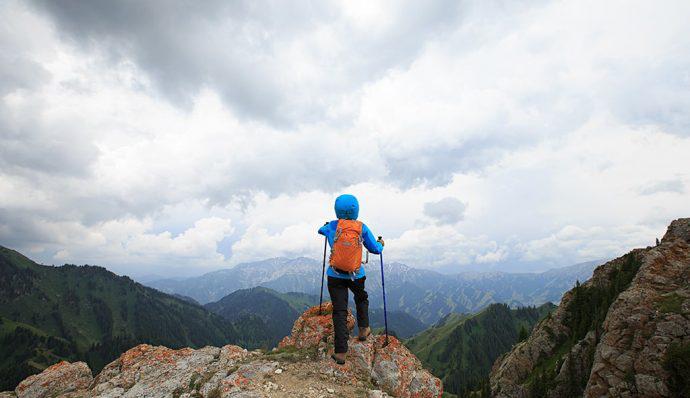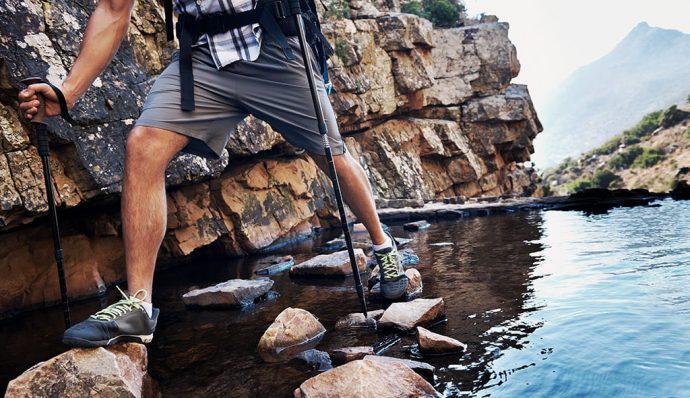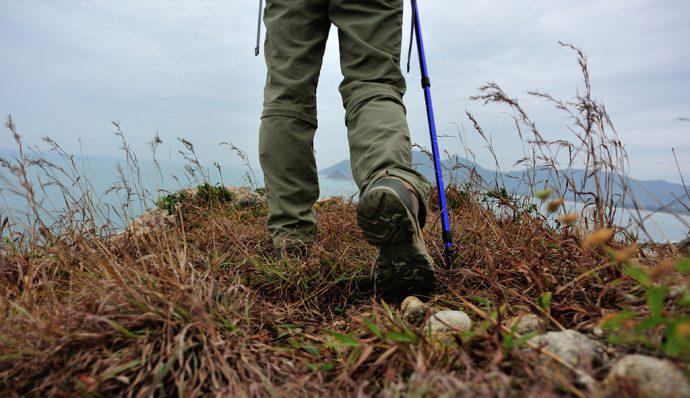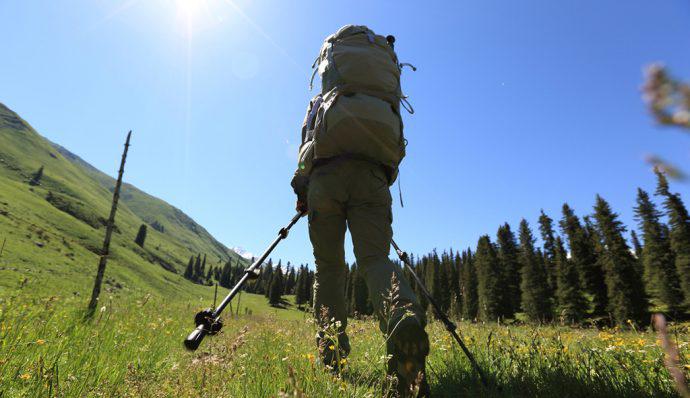I don’t know about you, but the first image that comes to mind when I think about a hiking staff is Gandalf in the Lord of the Rings trilogy. Anyone else? That said, trekking poles and hiking staffs are commonly used tools in the hiking world, regardless of whether or not you are an LoTR aficionado. The reason why is very simple: they provide balance and stability on all types of terrain. Before you even set foot on the trail, it’s a good idea to identify what hiking tool you should purchase.
Types of Trekking Poles
 There are two main types of trekking poles: a hiking staff and trekking poles. Sold as a pair, trekking poles look eerily similar to ski poles. However, they usually don’t have a basket on the end since you will likely use them on dirt and rock rather than in snow. A hiking staff is a single support pole that is best used on flat terrain when you are carrying minimal weight.
There are two main types of trekking poles: a hiking staff and trekking poles. Sold as a pair, trekking poles look eerily similar to ski poles. However, they usually don’t have a basket on the end since you will likely use them on dirt and rock rather than in snow. A hiking staff is a single support pole that is best used on flat terrain when you are carrying minimal weight.
What to Look For
Regardless of whether you opt for trekking poles or a hiking staff, you will want to keep a few factors in mind. First of all, pay attention to the length. You want a 90-degree angle bend in your elbow when holding on to your support pole, so be sure to purchase a pole that maintains this angle in your arm. After the length, the rest is all gravy — I mean, features! Various poles have different features. More bells and whistles tend to increase the price, but some of these add-ons are nice to have while trekking. Some of the features to watch out for include weight, packability, adjustable length, and locking mechanisms.
Features
 One of the prime features to pay attention to is an adjustable length. Fixed-length poles are still useful and are often a cheaper alternative to the fancier adjustable poles. If you know that you will largely be hiking on one type of terrain, a fixed-length pole is fine. In fact, a fixed-length pole will likely be lighter than an adjustable pole since it doesn’t have the extra components that add to the overall weight. However, having access to varying length comes in handy. If you are hiking uphill, you can shorten the pole to give yourself more leverage. The steeper the slope, the more you shorten the pole. The reverse happens on the downhill; hikers tend to lengthen the pole a bit to help reach for the ground in front of their feet. You can also use your poles to provide stability and support while traversing a slope. Simply lengthen the downhill pole and shorten the uphill pole. Voila! Balance from both sides. Many poles are now packable, or completely foldable. These poles typically break into three sections, allowing you to fold them up and store them inside your backpack. These are great options for ultra runners or hikers who will be trekking on mixed terrain. Perhaps you are summiting a mountain where the final mile involves major scrambling? Not a problem. Pack up your poles and you still have your hands free to move around. Some fancier poles have shock-absorbing features. This feature does exactly what it sounds like: absorbs some of the shock so that your body does not take the brunt of impact. Of course, this is a nice feature for anyone to have, but it is particularly useful if you are someone with bad knees or hips. In those situations, these poles can be the difference between a good day and a creaky walk to the car. Finally, many poles are now available in ultralight options. As you would imagine, these poles are not cheap, but they do serve a purpose. A lighter pole means less swing weight with each step. This requires less energy from you, which translates to less fatigue over time. Ultra runners may find these poles useful, as will thru-hikers who know they will be hiking for days upon days upon days.
One of the prime features to pay attention to is an adjustable length. Fixed-length poles are still useful and are often a cheaper alternative to the fancier adjustable poles. If you know that you will largely be hiking on one type of terrain, a fixed-length pole is fine. In fact, a fixed-length pole will likely be lighter than an adjustable pole since it doesn’t have the extra components that add to the overall weight. However, having access to varying length comes in handy. If you are hiking uphill, you can shorten the pole to give yourself more leverage. The steeper the slope, the more you shorten the pole. The reverse happens on the downhill; hikers tend to lengthen the pole a bit to help reach for the ground in front of their feet. You can also use your poles to provide stability and support while traversing a slope. Simply lengthen the downhill pole and shorten the uphill pole. Voila! Balance from both sides. Many poles are now packable, or completely foldable. These poles typically break into three sections, allowing you to fold them up and store them inside your backpack. These are great options for ultra runners or hikers who will be trekking on mixed terrain. Perhaps you are summiting a mountain where the final mile involves major scrambling? Not a problem. Pack up your poles and you still have your hands free to move around. Some fancier poles have shock-absorbing features. This feature does exactly what it sounds like: absorbs some of the shock so that your body does not take the brunt of impact. Of course, this is a nice feature for anyone to have, but it is particularly useful if you are someone with bad knees or hips. In those situations, these poles can be the difference between a good day and a creaky walk to the car. Finally, many poles are now available in ultralight options. As you would imagine, these poles are not cheap, but they do serve a purpose. A lighter pole means less swing weight with each step. This requires less energy from you, which translates to less fatigue over time. Ultra runners may find these poles useful, as will thru-hikers who know they will be hiking for days upon days upon days.
Locking Mechanisms
 Whether you use an adjustable pole or not, there will likely be a locking mechanism on your pole. Locking mechanisms are used to maintain the integrity of the length and to keep the pole from slipping in length when you place weight on it. For adjustable poles, this mechanism allows you to adjust the length in a few different sections. For fixed-length poles, the mechanism usually allows you to lock and unlock to extend or retract the pole length for storage or use. There are four main types of locking mechanisms used in trekking poles:
Whether you use an adjustable pole or not, there will likely be a locking mechanism on your pole. Locking mechanisms are used to maintain the integrity of the length and to keep the pole from slipping in length when you place weight on it. For adjustable poles, this mechanism allows you to adjust the length in a few different sections. For fixed-length poles, the mechanism usually allows you to lock and unlock to extend or retract the pole length for storage or use. There are four main types of locking mechanisms used in trekking poles:
- External Lever Lock: This is a clamp-like device on the outside of the pole that is easy to use, even with gloves on.
- Push-button Lock: This is an easy mechanism that locks into place and locks with one pull. Hikers simply need to press a button and the poles collapses.
- Twist Lock: These use an expander and screw setup to lock and release the pole length.
- Combination Lock: Sometimes poles use a mixture of the above mechanisms to achieve a balance of lightweight and support. For example, a pole could use an external lever lock on the top portion and a twist lock on the bottom.
Shaft Materials
There are two main materials used in the makeup of the trekking pole’s shaft:
- Aluminum: Aluminum poles are durable and affordable but tend to weigh more.
- Composite: Composite poles are usually partially or entirely made from carbon. These poles tend to be lighter than aluminum but they are pricier. Under heavy weight, they tend to splinter or break more frequently than aluminum.
Grip Materials
Just like with the shaft, trekking pole grips come in a few different materials that affect how the pole feels in your hand. The most frequently used materials are:
- Cork: Cork grips are breathable in warmer weather, which is great for sweaty hands. They also help insulate your hands in the cold. They will eventually form to fit the shape of your hand.
- Rubber: Rubber does not retain moisture, which makes this type of grip the best choice for cold-weather adventures. Rubber is also very efficient at reducing vibration, so these grips work well in high-alpine environments.
- Foam: Foam grips absorb moisture from your hands and are very soft to the touch. These grips work well for warm-weather hiking.
Women & Youth Poles
Most poles are unisex, but many are marked for men, women or children. In the end, find a pole that fits the height and weight you are most comfortable with, regardless of how it has been tagged by the store.
How to Use Trekking Poles
 Before you head into the wild, take a walk around your block to get used to using your poles. Fortunately, the learning curve is easy and you’ll be a pro in no time. Here are a few tips: Alternating: It will likely come naturally, but alternate your planted pole with your opposing foot. So, your left foot steps while your right pole plants. If you get confused, keep walking while letting your poles swing around. Before long, this rhythm will feel natural to you. Negotiating Obstacles: Poles come in handy when you are navigating around Mother Nature’s debris. Use their support to balance yourself while crossing a river, negotiating around a boulder, or even when stepping over a puddle. Double Plant: Sometimes it is helpful to plant both poles at the same time to garner leverage. I like to do this on steep climbs when I need a little bit of extra power to get me up the hill.
Before you head into the wild, take a walk around your block to get used to using your poles. Fortunately, the learning curve is easy and you’ll be a pro in no time. Here are a few tips: Alternating: It will likely come naturally, but alternate your planted pole with your opposing foot. So, your left foot steps while your right pole plants. If you get confused, keep walking while letting your poles swing around. Before long, this rhythm will feel natural to you. Negotiating Obstacles: Poles come in handy when you are navigating around Mother Nature’s debris. Use their support to balance yourself while crossing a river, negotiating around a boulder, or even when stepping over a puddle. Double Plant: Sometimes it is helpful to plant both poles at the same time to garner leverage. I like to do this on steep climbs when I need a little bit of extra power to get me up the hill.
Get trekking
If you plan on a tricky hike or just need a little extra help with balance and stability, trekking poles or a hiking staff is a good tool to purchase. Consider the different options and find which one fits your intended adventure best!


